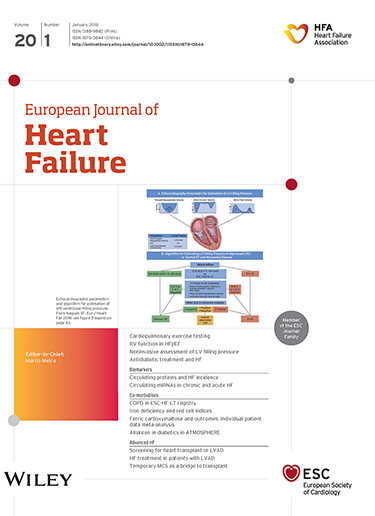The CONDUCT-AF trial: Rationale and design of a prospective, randomized, multicentre study comparing conduction system and biventricular pacing in patients undergoing atrioventricular node ablation for heart failure with atrial fibrillation.
IF 10.8
1区 医学
Q1 CARDIAC & CARDIOVASCULAR SYSTEMS
引用次数: 0
Abstract
AIMS There is a lack of data from randomized clinical trials comparing treatment outcomes between conduction system pacing (CSP) modalities and biventricular pacing (BVP) in symptomatic patients with refractory atrial fibrillation (AF) scheduled for atrioventricular node ablation (AVNA). The CONDUCT-AF investigates whether CSP is non-inferior to BVP in improving left ventricular ejection fraction (LVEF) and clinical outcomes in heart failure (HF) patients with symptomatic AF undergoing AVNA. METHODS This study is an investigator-initiated, prospective, randomized, multicentre clinical trial conducted across 10 European centres, enrolling 82 patients with symptomatic AF, HF with reduced LVEF, and narrow QRS. Participants will be randomized 1:1 to CSP or BVP with subsequent AVNA and followed for at least 24 months. The primary endpoint is the change in LVEF after 6 months. Secondary endpoints will include time to the first occurrence of worsening HF or cardiovascular death and its individual components, total number of HF hospitalizations, change in quality of life, N-terminal pro-B-type natriuretic peptide, 6-min walk test distance, and safety outcomes. CONCLUSIONS The CONDUCT-AF trial will provide critical insights into the optimal pacing modality for patients with HF and refractory AF undergoing AVNA. Recruitment is expected to conclude in 2025, with the first study results anticipated in 2026.传导-心房颤动试验:一项前瞻性、随机、多中心研究的基本原理和设计,比较传导系统和双室起搏在行房室结消融治疗心力衰竭合并心房颤动患者中的应用。
目的:目前还缺乏比较传导系统起搏(CSP)和双心室起搏(BVP)治疗难治性心房颤动(AF)患者房室结消融(AVNA)治疗结果的随机临床试验数据。CONDUCT-AF研究调查了CSP在改善心衰(HF)伴有症状性房颤患者行AVNA的左室射血分数(LVEF)和临床结果方面是否优于BVP。方法:本研究是一项研究者发起的前瞻性、随机、多中心临床试验,在10个欧洲中心进行,纳入82例有症状的房颤、心衰伴LVEF降低和QRS狭窄的患者。参与者将被1:1随机分配到CSP或BVP,随后进行AVNA,随访至少24个月。主要终点是6个月后LVEF的变化。次要终点将包括首次发生心衰恶化或心血管死亡的时间及其个别组成部分、心衰住院总人数、生活质量变化、n端前b型利钠肽、6分钟步行试验距离和安全性结果。CONDUCT-AF试验将为心衰合并难治性房颤患者行AVNA的最佳起搏方式提供重要见解。招募预计将于2025年结束,第一批研究结果预计将于2026年公布。
本文章由计算机程序翻译,如有差异,请以英文原文为准。
求助全文
约1分钟内获得全文
求助全文
来源期刊

European Journal of Heart Failure
医学-心血管系统
CiteScore
27.30
自引率
11.50%
发文量
365
审稿时长
1 months
期刊介绍:
European Journal of Heart Failure is an international journal dedicated to advancing knowledge in the field of heart failure management. The journal publishes reviews and editorials aimed at improving understanding, prevention, investigation, and treatment of heart failure. It covers various disciplines such as molecular and cellular biology, pathology, physiology, electrophysiology, pharmacology, clinical sciences, social sciences, and population sciences. The journal welcomes submissions of manuscripts on basic, clinical, and population sciences, as well as original contributions on nursing, care of the elderly, primary care, health economics, and other related specialist fields. It is published monthly and has a readership that includes cardiologists, emergency room physicians, intensivists, internists, general physicians, cardiac nurses, diabetologists, epidemiologists, basic scientists focusing on cardiovascular research, and those working in rehabilitation. The journal is abstracted and indexed in various databases such as Academic Search, Embase, MEDLINE/PubMed, and Science Citation Index.
 求助内容:
求助内容: 应助结果提醒方式:
应助结果提醒方式:


